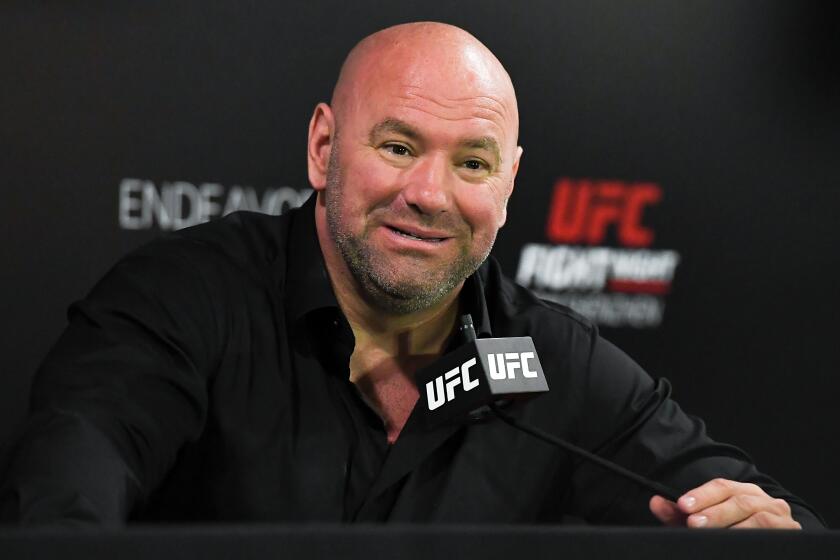COMMENTARY : Boxing Death Raises Brutality Questions
LAS VEGAS â The cheers of well-wishers rang in Gabriel Ruelasâ ears as he walked through the posh casino at Caesars Palace a few hours after defending his 130-pound title against Jimmy Garcia.
Ruelas, though, was in no mood for celebrating. Only a few feet away, tears ran down Manuel Garciaâs face as he followed through the casino the fighter who had just beaten his son to within an eyelash of death.
âThe father and brother were crying right behind me,â Ruelas recalled. âI felt like throwing punches right there at the people congratulating me. I was so enraged.â
While fight fans were eager to share in Ruelasâ moment of glory, Jimmy Garcia lay dying in a hospital a few miles away.
The surreal scene laid bare the nature of a sport whose brutality fascinates countless fans, yet whose inherent danger can prove deadly.
Four boxers have died in the last 14 months, and at least 38 have been killed in fights since South Koreaâs Duk Koo Kim died after a 1982 bout with Ray Mancini in the same Caesars Palace ring where Garcia was fatally injured.
Garcia died despite the best of medical foresight, including a ringside neurosurgeon who had him in the operating room within 35 minutes of his collapse in the ring.
âI believe in my heart we did everything right with Jimmy Garcia, but the boy still died,â said Marc Ratner, the commissionâs executive director. âI donât feel defensive about this. Hopefully we can learn something from it.â
The American Medical Association Council on Medical Affairs lists the annual number of boxing deaths at 0.13 per 1,000 participants, not out of line with other high-risk sports such as motorcycle racing, parachuting or hang gliding.
Many others, though, end up with some type of brain damage after taking repeated blows to the head. The AMA says three different studies show about three of every four boxers who have had more than 20 professional bouts show some brain deterioration.
âItâs not just the deaths but the chronic brain damage that is so frequent,â said Dr. George Lundberg, editor of the Journal of the American Medical Association. âThe main point is that blows to the head damage the brain.â
Garciaâs death has led the Nevada State Athletic Commission, considered the most progressive in the nation, to look at new ways of trying to reduce injuries and deaths in the ring.
Among those will be a study on weight loss before fights and a look at whether fights in which one boxer seemingly has no chance of winning should be stopped before the fighter gets in trouble.
âIf it was a perfect world, the kid would have survived, but he didnât,â Ratner said. âSo we have to reassess everything about that night and see what we can do differently.â
One issue raised in Garciaâs death was the weight he lost to make the 130-pound limit before his May 6 fight with Ruelas. Promoter Bob Arum said Garciaâs father told him the challenger had to lose 30 pounds, although Ratner said the father told him the fighter only lost 10 to 12 pounds before the fight.
âMy theory is he didnât have enough time to replenish the fluid in his brain after taking diuretics to make the weight,â Arum said. âHis brain didnât have protection.â
Doctors, though, have established no direct link between weight loss and brain injury in boxers, although the effect has not been widely studied.
âI donât think weight loss itself makes a difference, but no one has the answer,â said Dr. Albert Capanna, the neurosurgeon who operated to remove a blood clot from Garciaâs head. âI donât think anyone definitely can say if it does or doesnât.â
Those who point to sudden weight loss as a possible factor note that there are few serious head injuries among heavyweights, even though they hit the hardest of all boxers.
Not since 1933, when Ernie Schaaf died after being stopped in the 13th round of a fight with Primo Carnera in New York City, has a heavyweight been killed in the ring. During that same period, several hundred lighter fighters lost their lives.
âThe question is why heavyweights hit like hell and they donât have this cerebral bleeding,â Capanna said. âI canât remember a single heavyweight with a blood clot.â
The AMAâs Lundberg says he doesnât believe weight loss is an important factor in fighter injuries. He said fighters get injured because they get hit in the head.
âLosing the weight could have weakened the stamina and strength of Mr. Garcia and impaired his ability to defend himself,â Lundberg said. âBut it would have no bearing whatever on the sensitivity of brain structures to damage from blows to the head.â
Also in question is whether headgear, used now in all amateur bouts, would be effective in preventing injuries to the brain.
Heavyweight champion George Foreman has called for professional boxers to use headgear, but there has been little support for it.
âWe might as well ban boxing if that is the case,â former heavyweight champion Mike Tyson said about the idea. âItâs a fighterâs sport. This is a hurt business. In this business, things happen.â
Indeed, headgear has not prevented several amateur boxers from suffering blood clot injuries in the brain in recent years. But a study of amateur boxers by Johns Hopkins University shows that it might be proving effective against chronic brain damage, or the punch drunk syndrome.
Dr. Robert Voy, deputy chairman of the medical commission for Olympic boxing and a member of the board of directors of USA Boxing, said that studies of 480 amateur boxers begun in 1986 showed that headgear seemed to reverse the beginnings of brain damage seen in some of the boxers who hadnât used the protective covering before.
âSo far, so good but the study will have to be continued,â Voy said. âWhat we are seeing in this study, though, is that the potential is there for tests that might be able to indicate early problems going on that might prevent the type of injuries we have seen.â
Voy, though, said that headgear has many disadvantages, including the fact it absorbs sweat and makes a fighterâs head weigh more, increasing the pendulum effect blamed for many brain injuries.
It also gives an opponent a bigger target to hit, and hasnât seemed to be effective against the kind of hard punches that can cause sudden brain injury.
âStatistically, we havenât found yet that headgear has reduced the number of knockouts,â Voy said. âThat means the jury is still out as to whether headgear could or does prevent the type of injury seen in Jimmy Garcia.â
Lundberg, an outspoken foe of boxing, also has his own view on that, calling the use of headgear âequivalent to having referees wear tuxedos.â
âIt dresses up the sport, but it doesnât do any good,â Lundberg said. âHeadgear has no benefit except of the conscience of people who think theyâre doing good, but actually only giving window dressing to the sport.â
Capanna and other ringside physicians at odds with the AMA over the issue of boxing donât deny that it can be a dangerous sport. But they argue that banning boxing would force it underground, where there would be no doctors standing by or ambulances just outside.
âI donât think you can outlaw sports,â Capanna said. âIf you outlaw boxing, theyâll still do it, either in some other country, in offshore barges, or, at worst, underground. Theyâll have no prefight physicals, no medical help. It will be much worse for the fighters themselves.â
Capanna said there is danger in all sports, particularly football where players are coached to hit an opponent as hard as they can.
âNothing is benign,â he said. âOne day last year I operated on two golf injuries in the same day. One had a subdural hematoma such as the one suffered by Jimmy Garcia from being hit with a golf ball and he later died. Another got hit in the forehead by his brother with a 9-iron.â
More to Read
Go beyond the scoreboard
Get the latest on L.A.'s teams in the daily Sports Report newsletter.
You may occasionally receive promotional content from the Los Angeles Times.










